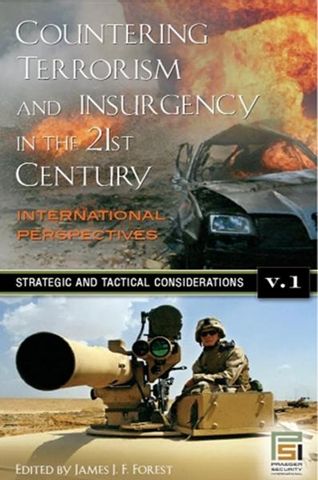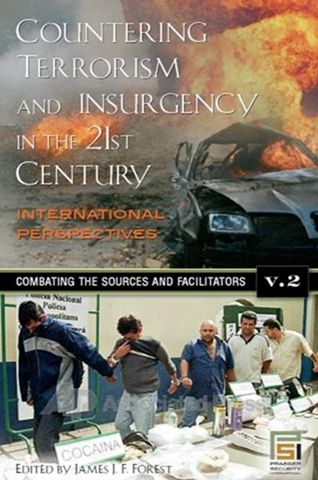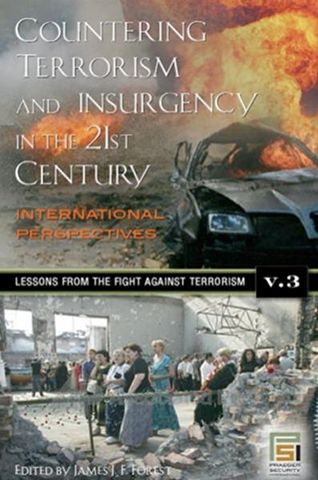|
GTI Experts Co-Author West Point Training Publication June 1, 2007 By Government Training Institute Government Training Institute, Inc., a leading military and law enforcement tactical training organization, today announced terrorism expert Peter Spagnolo's contribution to "Countering Terrorism and Insurgency in the 21st Century." The book was edited by Professor James Forest who teaches at the Combating Terrorism Center and will be used to help educate and train students at West Point. GTI's contributors covered the role of state and local police departments play with an emphasis on SWAT. The book will be utilized at West Point. Others contributors of the publication include:
"It is truly an honor to be published in a scholarly publication amongst such prestigious contributors" said GTI president Chadd Harbaugh. Copies of the book can be purchased online. Order Now! Countering Terrorism and Insurgency in the 21st Century: International Perspectives James J.F. Forest, Editor Published by PRAEGER SECURITY INTERNATIONAL Advisory Board: Bruce Hoffman, Rohan Gunaratna, James Robbins
Reviews: * This three-volume collection edited by Forest gathers together dozens of experts, military and academic, on the topic of global terrorism. Forest has written a preface and introduction to each volume. In effect, contributors' essays answer such questions from Forest as "What do we know about effectively countering terrorism?", "What are the characteristics of successful or unsuccessful counterterrorism campaigns?", and "What do we need to learn in order to better handle this threat?" Forest notes that terrorism has been around for hundreds of years and that the ability of terrorists to adapt to the changing international environment, use technology, and maintain lines of communication helps them remain viable. He recognizes that no single method will be successful in eradicating terrorism but advocates that nations themselves adapt by using not just greater technology but greater international communication and cooperation. * Aiming to "encourage the development of learning organizations among national security professionals by examining what we currently know about the strategic application of hard and soft power in countering the sources and facilitators of terrorism," Forest presents a three-volume set of some 60 thematic essays and case studies summarizing existing knowledge in the field of counterterrorism and counterinsurgency, largely from the perspective of the industrialized democracies. VOLUME I: STRATEGIC AND TACTICAL CONSIDERATIONS 1. Strategies and Tactics for Countering Terrorism: An Introduction | James J.F. Forest: Combating Terrorism Center at West Point Part I: Strategic and Policy Dimensions 2. U.S. Grand Strategy for Countering Islamist Terrorism and Insurgency in the 21st Century | Brad Bowman: U.S. Military Academy 3. Thinking Strategically: Can Democracy Defeat Terrorism? | Douglas A. Borer and Michael Freeman: Naval Postgraduate School 4. Twenty-First Century Insurgencies: The Use of Terrorism as a Strategy | Leonard Weinberg and William Eubank: University of Nevada 5. Developing and Implementing Counterterrorism Policy in a Liberal Democracy | Jennifer Holmes: University of Texas, Dallas 6. Morality, Ethics and Law in the Global War on Terrorism (the Long War) | Harvey Rishikof: National War College 7.The Critical Role of Interagency Cooperation in Combating Suicide Bombings | James D. Kiras: SAASS, Maxwell Air Force Base 8. The U.S. Government's Counterterrorism Research and Development Programs | Michael B. Kraft: Counterterrorism Consultant Part II: Hard Power 9. National Objectives in the Hands of Junior Leaders | Amos N. Guiora and Martha Minow: Case Western University School of Law and Harvard Law School 10. Engaging Military Contractors in Counterterrorism Operations | James Carafano and Alane Kochems: The Heritage Foundation 11. Manhunting: A Process to Find Persons of National Interest | Steven Marks, Thomas Meer, & Matthew Nilson: United States Army & U.S. Air Force 12. Guerilla Warfare and Law Enforcement: Combating the 21st Century Terrorist Cell Within the United States | Richard J. Hughbank: United States Army 13. Combating Terror in U.S. Communities: The SWAT Mission | Peter N. Spagnolo and Chadd Harbaugh: The Government Training Institute Part III: Soft Power 14. Denying Terrorists Sanctuary through Civic and Military Action | Robert J. Pauly and MAJ Robert Redding: The University of Southern Mississippi and U.S. Army Special Forces 15. Battlefronts in The War of Ideas | James S. Robbins: National Defense University 16. The Centrality of Ideology in Counter-Terrorism Strategies in the Middle East | Maha Azzam: Chatham House 17. Public Diplomacy as Strategic Communication | Bruce Gregory: Public Diplomacy Institute, The George Washington University 18. Cyber Mobilization: The Neglected Aspect of Information Operations and Counterinsurgency Doctrine | Timothy L. Thomas: Foreign Military Studies Office, U.S. Army 19. The Key Role of Psychological Operations in Countering Terrorism | Jerrold Post: George Washington University Part IV: Intelligence and Counterintelligence 20. The Contemporary Challenges of Counterterrorism Intelligence | Jennifer Sims: Georgetown University 21. Multinational Intelligence Cooperation | Tom Lansford: University of Southern Mississippi 22. Intelligence Coordination and Counterterrorism: A European Perspective | Magnus Norell: Swedish Defence Research Agency 23. Dilemmas of Coping with Terror: Lessons Learned from the Israeli Secret Services | Ami Pedahzur and Arie Perliger: University of Texas and University of Haifa 24. Open Source for Counterterrorism: Facilitating Interagency Communication and Open Source Intelligence | Orion A. Lewis and Erica Chenoweth: University of Colorado and Harvard University 25. Al-Qaeda's Surveillance Offensive Against America, 1997-2001: Implications for Countersurveillance | Aaron Danis: Nuclear Regulatory Commission 26. Forecasting Terrorist Groups' Warfare: 'Conventional' to CBRN | Joshua Sinai: The Analysis Corp. Appendix A: U.S. National Security Strategy | Appendix B: U.S. National Strategy for Combating Terrorism | Bibliography | Index VOLUME II: SOURCES AND FACILITATORS
1. Combating the Sources and Facilitators of Terrorism: An Introduction | James J.F. Forest: Combating Terrorism Center at West Point Part I: Governments and the International System 2. Combating State Sponsors of Terrorism | Dan Byman: Georgetown University 3. The Democratic Deficit: The Need for Liberal Democratization | Paul Pillar: Georgetown University 4. The Role of Democratization in Reducing the Appeal of Extremist Groups in North Africa and the Middle East | Francesco Cavatorta: Dublin City University 5. Authoritarian and Corrupt Governments | Lydia Khalil: NYPD 6. State Failure and Terrorism | Matthew H. Wahlert: Miami University 7. Border Controls and State Insecurity | Michelle L. Spencer: Security Consultant Part II: Criminal and Economic Dimensions 8. Combating the International Proliferation of Small Arms and Light Weapons | Chris Carr: Air War College 9. Terrorism Finance: Global Responses to the Terrorism Money Trail | Paul J. Smith: Naval War College 10. Organized Criminal Networks and Terrorism | JP Larsson: UK Home Office 11. The Global Drug Trade and its Nexus to Terrorism | Gregory D. Lee: Criminal Justice Consultant 12. Afghanistan's Transformation to a Narco-Terrorist State: An Economic Perspective | James Walker and Jon Byrom: U.S. Military Academy 13. The Shadow Economy and Terrorist Infrastructure | Shahdad Naghshpour and Joseph J. St. Marie, The University of Southern Mississippi; and Samuel S. Stanton, Jr, Grove City College 14. Energy Dependence | Sumesh Arora and David Butler: The University of Southern Mississippi 15. Red Sky In The Morning: The Nexus between International Maritime Piracy and Transnational Terrorism | Kent Baumann: George C. Marshall Center, U.S. Army 16. Understanding and Countering the Motives and Methods of Warlords | Brian Hanley: KonnectWorld, Inc. Part III: Society, Technology and Strategic Influence 17. Responding to Psychological, Social, Economic and Political Roots of Terrorism | Bard O'Neil and Donald J. Alberts: National Defense University 18. Suicide, Homicide or Martyrdom: What's in a Name? | Christopher L. Brown: Center For Security Policy 19. Understanding and Combating Education for Martyrdom | Magnus Norell and Eli Göndör: Swedish Defence Research Agency 20. Terrorism and New Media: The Cyber-Battlespace | Maura Conway: Dublin City University 21. Cry Terror and Let Slip the Media Dogs | Randy Bowdish: USMC Command and Staff College 22. The Role of Al-Manar (Hizballah's TV station) in Supporting Terrorism | Maura Conway: Dublin City University 23. Socio-Cultural, Economic and Demographic Aspects of Counterterrorism | Christopher Jasparro: USMC Command and Staff College Part IV: U.S. Responses to the Global Security Environment 24. Terrorism, Insurgency and Afghanistan | Thomas H. Johnson and Chris Mason: Naval Postgraduate School 25. Fighting al Qaeda: Understanding the Organizational, Ideological, and Financial Aspects of a Global Network of Terror | Joseph L. Trafton: University of Rhode Island 26. Iraq in the 21st Century | Robert J. Pauly and Jeff Stephens: University of Southern Mississippi 27. The Trans-Sahara Counterterrorism Initiative: America's New Commitment to Africa | Lianne Kennedy: United States Military Academy 28. Values, Emotions and the Global War on Terror | John B. Alexander: Joint Special Operations University Appendix: The United Nations Global Counterterrorism Strategy | Bibliography | Index VOLUME III: LESSONS LEARNED FROM THE FIGHT AGAINST TERRORISM 1. Introduction to the Comparative Study of Counterterrorism | James J.F. Forest: Combating Terrorism Center at West Point 2. Educating the Next Generation of Counterterrorism Professionals | Stephen Sloan: University of Central Florida Part I: Case Studies of Terrorist Attacks and Counterterrorism Operations 3. Hijacking of TWA Flight 847 | Rick Wrona: Combating Terrorism Center at West Point 4. Hijacking of the Achille Lauro | Sean Anderson and Peter Spagnolo: CT Training Center 5. The February 1993 Attack on the World Trade Center | Daniel Baracskay: Valdosta State University 6. The August 1996 Chechen Takeover of Grozny | James S. Robbins: National Defense University 7. The U.S. Embassy Bombings in Kenya and Tanzania | Sundara Vadlamudi: Monterey Institute for International Studies 8. The Case of Ramzi Youssef | Gary Ackerman: Monterey Institute of International Studies 9. Yemen and the Attack on the USS Cole | Ruth Margolies Beitler: United States Military Academy 10. Capturing Khalid Sheik Mohammed | Robert Wesley: [U.S. Government Agency] 11. The Seige of Beslan's School No. 1 | Adam Dolnik: University of Wollongong, Australia 12. The Madrid Attacks on March 11: An Analysis of the Jihadist Threat in Spain and Main Counterterrorist Measures | Rogelio Alonso: King Juan Carlos University 13. The London Terrorist Attacks of July 7, 2005 | Tom Maley: Cranfield University 14. The April 1995 Bombing of the Murrah Federal Building in Oklahoma City | Daniel Baracskay: Valdosta State University Part II: Case Studies of the Long-Term Fight Against Terrorism 15. State Response to Terrorism in Sri Lanka | Tom Marks: National Defense University 16. Countering West Germany's Red Army Faction: What Can We Learn? | Joanne Wright: Holloway College, London 17. Countering Terrorism in Latin America: The Case of Shining Path in Peru | David Scott Palmer: Boston University 18. A Slow Road to Victory: Counterinsurgency and Strategic Innovation in Colombia | Nicolás Urrutia Iriarte and Román D. Ortiz: University de Los Andes 19. The Wars in Chechnya and the Decay of Russian Democratization | Thomas Sherlock: United States Military Academy 20. Italy and the Red Brigades: The Success of Repentance Policy in Counterterrorism | Erica Chenoweth: Harvard University 21. Lebanon, Hizballah, and the Patrons of Terrorism | Rick Wrona: Combating Terrorism Center at West Point 22. Turkey and the PKK | Lydia Khalil: NYPD 23. Israel's Struggle Against Palestinian Terror Organizations | Joshua L. Gleis: Tufts University 24. Fighting Fire with Fire: Destroying the Syrian Brotherhood | Brian Fishman: United States Military Academy 25. State Power and the Progress of Militant and Moderate Islamism in Egypt | Sherifa Zuhur: U.S. Army War College 26. Counterterrorism Policies and the Revolutionary Movement of Tupac Amaru: The Unmasking of Peru's National Security State | Vera Eccarius-Kelly: Siena College 27. Moro Insurgents and the Peace Process in the Philippines | Robin L. Bowman: U.S. Air Force Academy 28. Terrorism and Uzbekistan: The Threat and the Response | Joshua Sinai: The Analysis Corp 29. India's Response to Terrorism in Kashmir | Behram A. Sahukar: Indian Army (Retired) 30. Combating Terrorism in Nepal | Tom Marks: National Defense University 31. Japan and Aum Shinrikyo | James M. Smith: USAF Institute for National Security Studies 32. The Struggle with Violent Right-Wing Extremist Groups in the United States | Eric Shibuya: USMC Command and Staff College Bibliography ABOUT THE EDITOR |


